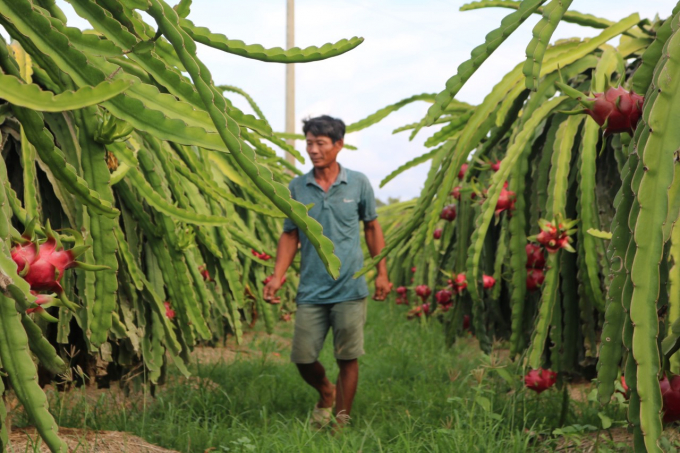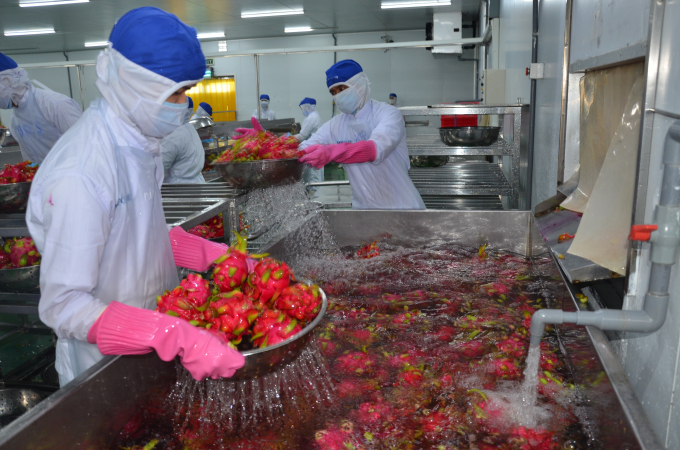November 25, 2025 | 19:02 GMT +7
November 25, 2025 | 19:02 GMT +7
Hotline: 0913.378.918
November 25, 2025 | 19:02 GMT +7
Hotline: 0913.378.918
According to Binh Thuan People's Committee , the province had 502 agricultural groups with 1,797 participating households; 35 cooperatives, 1 coopertive union including 673 members and 1 cooperative growing Global GAP-certificated dragon fruits on 1,384 hectares. In addion, 7 cooperatives owning their own processing and packaging facilties collected dragon fruits from its member,forming production linkages.

The prices of Vietnamese dragon fruits plunge in face of the strict control from the Chinese market. Photo: Kim So.
Besides, the province had above 200 dragon fruit farms with the scales of tens to hundreds of hectares. Thanks to the introduction of mechanization on production, farming methods have been improved. Especially, many dragon fruit farms have applied smart technology to water, fertilizer and spray the plants. Additionally, trellis or T-Bar production system in combination with automatic watering system and mechanization has been put into use for around 500 hectares of dragon fruit in the province.
However, according to Mai Kieu, Director of the Department of Agriculture and Rural Development of BinhThuan, there were some limitations to the development of dragon fruit production in the province including small scale farming, the lack of concentrated cultivation areas and short supply of high-quality, making BinhThuan's dragon fruit less competitive in the market.
Along with that, low quality and weakness in processing and preservation make Vietnam dragon fruits less competitive in the market. Because of unstable market and volatile prices as well as the dependence on the Chinese market, the consumption of dragon fruits has faced difficulties over the past years.
Particularly, dragon fruit prices have recently dropped sharply to only few thousand dongs per kilo as China suspended trade at Vietnam border gates, leading to congestion of agricultural goods.

A dragon fruit-growing area in Ham Minh commune, Ham Thuan Nam district (BinhThuan province). Photo: Le Khanh.
Apart from the impact of diseases on the quality of dragon fruit, most of exporting enterprises were lack of capital and skilled labor to apply technologies and expand consumption market
Bien Tan Lai, Deputy Director of BinhThuan’ Department of Industry and Trade said only 15% of the total production of 700,000 tons of dragon fruit produced in the province were consumed in the domestic market, the remaining 85% were exported. Of which the proportion of dragon fruits exported through the formal channels accounted for a small part (2-3%), the rest was consumed through cross-border trade with Chinese traders or via middle- enterprises.
Likewise, dragon exports of the provinces of Long An and Tien Giang have been highly dependent on the Chinese market. Nguyen Van Man, Director of Tien Giang’s Department of Agriculture and Rural Development said 150,000 tons out of the total output of 260,000 tons of dragon fruit produced in the province every year were export to China.

In case of market crash, Vietnamese dragon fruit producers have to manage on their own devices. Photo: Kim So.
Meanwhile, Long An exported around 250,000 tons of dragon fruit to China, 75,000 tons to the US and 42,000 tons to EU and other markets every year. Only about 20,000 tons were consumed in the domestic market.
One of the biggest problems dragon fruit producers in Tien Giang, Binh Thuan and Long An have faced was high dependence on the Chinese market. Particularly, dragon fruit consumption has recently faced difficulties as China tightened border with Vietnam. As a result, prices have dropped to VND2,000-VND3,000 per kilo.
Dr. Tran Minh Hai, Director of Central Agricultural Cooperative Management School said it was not easy for dragon fruit-growing areas of Vietnam to develop linkage chains because most of the cooperatives thought of their own benefits first instead of taking care for the local community. Another problem of Vietnamese dragon fruit industry was abundant quantity but low quality, making the fruit difficult to access the highly-demanding markets.
According to Bien Tan Tai, the Chinese market has been thought to be easy to access. However, in recent years, that thought has changed. Particularly since the Covid-19 outbreak China has tightened its custom control at land border crossing as part of its “Zero Covid” policy. The country has also strengthened quarantine measures as well as quality and traceability control of goods, especially agricultural products including dragon fruit imported from Vietnam.

It’s important for Vietnamese enterprises to comply with regulations and foreign import requirements. Photo: Le Khanh.
Exporters have to register the General Administration of Customs of China for codes to be allowed to export commodities to the Chinese market which has been affecting consumption of farm produce including Binh Thuan's dragon fruit in this market.
On the other hand, most of the dragon fruit exporters in BinhThuan are small and medium sized and they have not yet paid attention to trading in accordance with foreign regulations and import requirements to reduce the risk that may occur through trading in the informal channels.
Also related to the Chinese market, Dr.Tran Minh Hai - Director of Central Agricultural Cooperative Management School said China is now having a large area of dragon fruit and when dragon fruit harvest season gets underway they will do everything they can to protect the domestic market. Therefore, the golden age of Vietnam's dragon fruit exports to China has been over. Moreover, dragon fruit has been cultivating in many Asian countries including Cambodia. Currently, Cambodia's dragon fruit-growing area is 12,800 hectares, compared to 3,000 hectares five years ago.

It's high time for Vietnam to reshape its strategy on dragon fruit production and export. Photo: Kim So.
Meanwhile Tran Ngoc Hiep, Director of Hoang Hau Dragon Fruit Farm Company Limited (Binh Thuan province) said the expansion of dragon fruit plantation area and output in China has directly affected the exports of Vietnam dragon fruit to this market.
In the past, the main harvest season of dragon fruit in China was from May to October but Chinese farmers have now grown off-season dragon fruits. According to Hiep, even without congestion of goods at China border, the prices of dragon fruit exported to China will be cheaper and cheaper because of abundant supply.
Binh Thuan's dragon fruits were mainly purchased by enterprises or business households then transported to border gates in Northern provinces.
In the 2016-2020 period, Binh Thuan exported nearly 32,000 tons of dragon fruit valued at US$37.1 million through formal channel. In 2021, Binh Thuan exported 5,560 tons of dragon fruit worth US$8.3 million, reaching 94.3% of the plan, down 0.7% in value and down 21% in volume compared to the prior year.
Translated by Mai Tham

(VAN) An Giang promotes supply-demand connections, standardizes quality and builds value chains, creating a foundation for sustainable bird’s nest development and aiming to expand exports.
/2025/11/24/5339-4-nongnghiep-075331.jpg)
(VAN) Recently, the conference on 'Sustainable Fisheries Linkage Chain - Tilapia for Export' took place in Tien Hai commune, Hung Yen province.
/2025/11/21/4309-2-153400_128.jpg)
(VAN) Green and low-emission rice is paving the way for Vietnamese rice to enter high-end markets, marking the beginning of a transformation journey toward greening and elevating the national rice brand.

(VAN) ‘Right to Win’ outlines a national action plan that shapes a new vision for Viet Nam’s agriculture in an era of renewal and global integration.

(VAN) Lam Dong’s farmed sturgeon output this year is expected to reach 2,300 tons, worth VND 450 billion, affirming the brand’s position on the market.

(VAN) A surge in Ukrainian egg exports, largely driven by soaring sales to the UK over the last few years, has notably pushed up egg prices on the domestic market.

(VAN) The price of Arabica Catimor coffee in Quang Tri is currently at VND 25,000–27,000/kg (fresh cherries), the highest level ever recorded